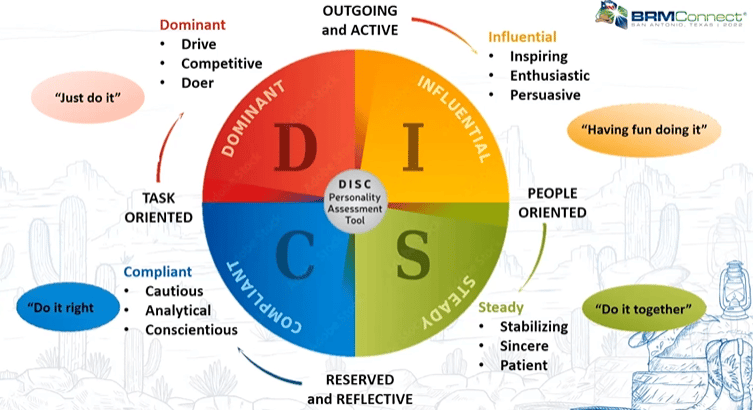Your BRM Superpower

Right out of the gate, day two of BRMConnect is looking just as promising as day one! Darrel Popowich, from Online Business Systems, broke down the power behind evaluating relationships in his general session titled “Your BRM Superpower.”
With his ability to engage the crowd and impress us with his graphics, Popowich not only spoke about the four common characteristics in relationships, but he also discussed the two different decision-making systems we have within our brains and the connection those systems have to the four distinct types of personality traits we possess as humans. He says it’s predicting success by evaluating relationships.
Break It Down
This is how he broke it down. But first, he pointed out that in the past, many people would choose to do a stakeholder’s analysis and look at the things that would make them successful. They would look at customers, employees, suppliers, and community, but Popowich chose to look at owners.
Owners?
The owners are the ones who drive the outcome. The owners are the ones pushing if they are going to commit and collectively get something done, and if they are going to accomplish the outcome. This is where he chose to focus because there are so many people who say, “We did a stakeholder’s analysis, and we still have a poor outcome and result.”
People’s Relationships
As Popowich claimed, you are looking at the wrong thing; you should be looking at people. This is your stakeholder’s/partner’s analysis: instead of looking at each part—community, government, customers—let’s take a look at the owners. It’s not the owners themselves, it’s about evaluating the relationships between them, how strong they are from people to finance, from the finance leader to the procurement leader, from the IT leader to the CEO, to the CFO to the COO, all of these relationships. If we measure those, we can get a better indicator on whether your results are going to be successful or not. There are four common characteristics in relationships that stood out in all the data.

4 Common Characteristics in Relationships
Trust
Am I going to be supported?
Respect
Can they do their jobs?
Commitment
Are you committed to supporting each other through thick and thin?
Communication
Do they say what’s on their mind?
How does the human mind make decisions? Well first, he said we have to understand the two different decision-making parts of our brains. According to Daniel Kahneman, there are two systems of decision making that humans have and utilize.
2 Systems of Decision Making
If the two systems don’t mesh well, there will be a lot of work to change the decision and the behavior to get both the autonomic and analytical brains to match up. But everyone is not the same. Not everyone’s makeup of how their first impression, how their logical decision making, the process, the speed of which they go through, is the same. There are many different behavior types and many different ways to measure them. Popowich uses the DISC Personality Assessment Tool.
-
Autonomic/quick/intuitive
-
Sensory cortex & basal gangela
-
Intuitive, quick, millisecond
-
Fight or flight
-
Insta-love/hate
-
-
-
Analytical/executive function/thought process/math
-
Hippocampus
-
Memory storage & recollection
-
Information gathering
-
Analytical decision
-
-
DISC
The DISC Personality Assessment Tool measures how people have their natural behavioral responses to situations and to other people. DISC is divided into four personality types: dominant, influential, steady, and compliant, hence the acronym DISC.

DISC is presented in a circle. On the top left, you see Dominant, and on the top right is Influential. The bottom right is Steady, and the bottom left is Compliant.
Dominant
Drive. Competitive. Doer.
Influential
Inspire. Enthusiastic. Persuasive.
Steady
Stable. Sincere. Patient.
Compliant
Cautious. Analytical. Conscientious.
If we pull back from the four different personality types, we find there is a range that these four personalities function in, from task oriented to people oriented, and from outgoing and active to reserved and reflective.
First Impressions
The reason why these four areas of function are so important is because this is where we find first impressions are formed. A dominant person who is task oriented may have a negative first impression of someone who’s personality is more like the steady type, and visa-versa. We mix and match our personality types by making a good first impression.
It’s important to understand that the human brain decides quickly and then takes a long time to go through the analytics. Human beings are different, and how they go about making logical and analytical decisions is different. When you start to understand that, you can start measuring relationships and measure the strength of them against the four common characteristics of relationships: trust, respect, commitment, and communication.
The Power of 7
We have seven seconds to make a first impression and earn that next seven minutes. Seven seconds to gain seven minutes isn’t much time. You have to lay the foundation, measure the relationship, and have the conversation around how to earn someone’s seven minutes one-on-one so you can tailor the first impression decision, the response, and the reaction.
As a BRM, you have to create your executive presence. In order to create your own executive presence, you need to be okay with having a say and creating a disruption. You need a voice and a say in order to present yourself as a leader.
- Gain interest of the stakeholders (partners) in the room.
- Exude self-confidence.
- Be able to exercise restraint when someone is attacking you.
- Respond with respect and kindness.
- Know the right time to pause, raise your voice, or lower it.
- Know the right time to let silence speak volumes.
- Evaluate what each and every person needs.
- Know what questions they might ask.
- Know what questions they usually ask.
- Having your presentation ready.
- Know why, what, when, where, who, and how.
- Know you will have to get back to them with answers.
- Practice the pitch.
- Practice the conversation.
- Practice being quiet.
If you practice with preparation, the poise will come naturally! Then, as you become better at this, it will establish your executive presence. That first impression builds trust within the relationship with your partner, to where they aren’t asking themselves if you can handle going into the meeting without them. You have proven you can. It’s important to understand the strength of relationships.
Popowich went on to break down the power of meeting in person, and how impactful it is to look someone in the eyes to connect and engage and believe in the other person. It is the relationships between people that will determine if you’re going to push through quickly with speed and urgency or whether the relationship will become stagnant and fester. It is the difference between partners moving onto the next thing with you or choosing to move on to something else without you. Remember, we are all different, and it’s how you decide to move forward that will make the difference. Look at where you’ve been and see where you are going.
If you’ve enjoyed this recap of Darrel Popowich’s “Your BRM Superpower” from this year’s BRMConnect conference in San Antonio, Texas, make sure you don’t miss out on the other session recaps.